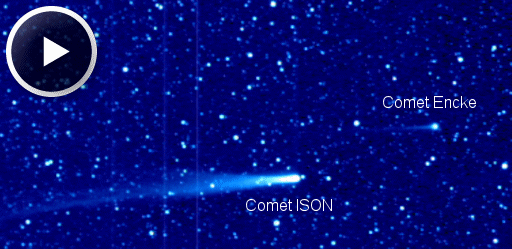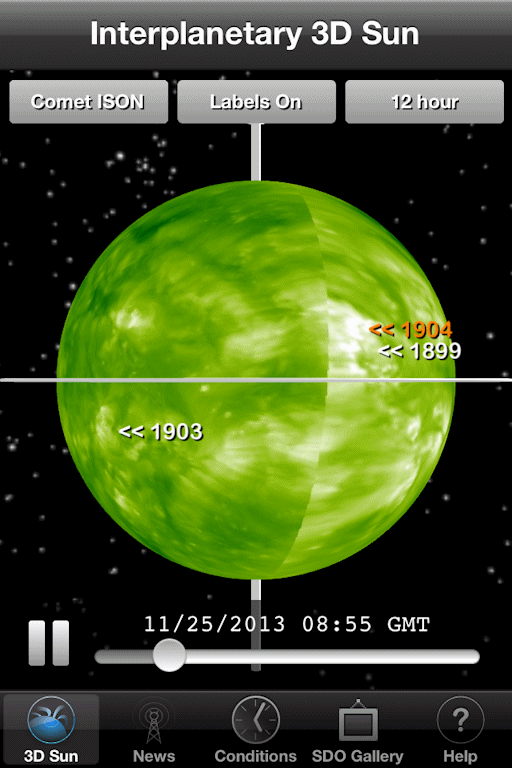When is the best time to see auroras? Where is the best place to go? And how do you photograph them? These questions and more are answered in a new book, Northern Lights - a Guide, by Pal Brekke & Fredrik Broms. | | |
NIGHT-SHINING CLOUDS REAPPEAR OVER ANTARCTICA: The southern season for noctilucent clouds (NLCs) is underway. NASA's AIM spacecraft detected the first wispy tendrils of NLCs over Antarctica on Nov. 21st and since then the electric-blue clouds have spread and brightened. Scroll down the page and look left for latest images.
IS COMET ISON IN TROUBLE? Astronomers using the IRAM millimeter telescope in Spain are reporting a sharp change in Comet ISON. "We observe consistent, rapid fading of the molecular emission lines between Nov. 21 and Nov. 25 by at least a factor of 20. This may indicate that the nucleus is now at best marginally active or that... it no longer exists," says Michal Drahus of Caltech.
It's too soon to panic, though. First, click on the image to watch a movie from NASA's STEREO-A spacecraft (31 MB), then scroll down for continued discussion:

Credits: This movie was made by reader Rob Matson using data from STEREO-A.
The movie spans a 3+ day interval from Nov. 21 (00:09 UT) to Nov. 24 (08:09 UT), which overlaps the period when IRAM recorded the fading emission lines. Zoom your movie-player to full screen: Although "puffs" of material can be seen billowing down the comet's tail, the comet itself does not appear to be disintegrating. Moreover, a STEREO-A image taken just hours ago shows ISON still shining brightly.
Astronomer Karl Battams of NASA's Comet ISON Observing Campaign comments: "[The fading emission lines] could indicate that the nucleus has completely disrupted, releasing an enormous volume of dust while significantly reducing emission rates. Fragmentation or disruption of the nucleus has always been the highest risk factor for this comet so if this has indeed happened then while unfortunate, it would not be a surprise."
"However," he continues, "these reports are new, and while they are undoubtedly valid, we do still need to keep observing the comet to be sure what it happening. Remember: Comet ISON is a dynamically new sungrazing comet, fresh in from the Oort Cloud, and the last time we saw an object like this was never! Furthermore, a sungrazing comet just three days from perihelion has never been studied in this kind of detail - we're breaking new ground! When we factor in your standard 'comets are unpredictable' disclaimer, what we have is a huge recipe for the unknown."
Stay tuned for updates.
Realtime Comet ISON Photo Gallery
WHICH SIDE OF THE SUN IS FACING COMET ISON? When Comet ISON sweeps through the sun's atmosphere on Nov. 28th, it will be in the 'hot zone' for CMEs. A strike by one of the massive storm clouds probably wouldn't destroy the comet, but it could have a dramatic effect on the comet's fragile tail. The odds of a strike depend on which side of the sun is facing the comet at the time of the flyby. This is something you can monitor using a NASA iPhone app called the Interplanetary 3D Sun:

The app displays an interactive 3D model of the entire sun photographed by extreme UV cameras onboard NASA's twin STEREO probes. The data are realtime and fully interactive (pinch, spin and zoom). As shown in this target list, you can view the sun from many locations around the solar system--including Comet ISON.
Active regions are color-coded by their potential for flares: Orange means "expect M-class solar flares," while red denotes sunspots capable of X-flares. In the screen shot above we see that Comet ISON is bearing down on an active region, AR1904, that poses a threat for M-class eruptions. A CME might be in the offing after all. Solar flare alerts: text, voice
Realtime Space Weather Photo Gallery
Realtime Aurora Photo Gallery
Every night, a network of
NASA all-sky cameras scans the skies above the United States for meteoritic fireballs. Automated software maintained by NASA's Meteoroid Environment Office calculates their orbits, velocity, penetration depth in Earth's atmosphere and many other characteristics. Daily results are presented here on Spaceweather.com.
On Nov. 25, 2013, the network reported 11 fireballs.
(9 sporadics, 1 Leonid, 1 November omega Orionid)

In this diagram of the inner solar system, all of the fireball orbits intersect at a single point--Earth. The orbits are color-coded by velocity, from slow (red) to fast (blue). [Larger image] [movies]
Potentially Hazardous Asteroids (
PHAs) are space rocks larger than approximately 100m that can come closer to Earth than 0.05 AU. None of the known PHAs is on a collision course with our planet, although astronomers are finding
new ones all the time.
On November 26, 2013 there were potentially hazardous asteroids.
Notes: LD means "Lunar Distance." 1 LD = 384,401 km, the distance between Earth and the Moon. 1 LD also equals 0.00256 AU. MAG is the visual magnitude of the asteroid on the date of closest approach. | | The official U.S. government space weather bureau |
| | The first place to look for information about sundogs, pillars, rainbows and related phenomena. |
| | Researchers call it a "Hubble for the sun." SDO is the most advanced solar observatory ever. |
| | 3D views of the sun from NASA's Solar and Terrestrial Relations Observatory |
| | Realtime and archival images of the Sun from SOHO. |
| | from the NOAA Space Environment Center |
| | the underlying science of space weather |

